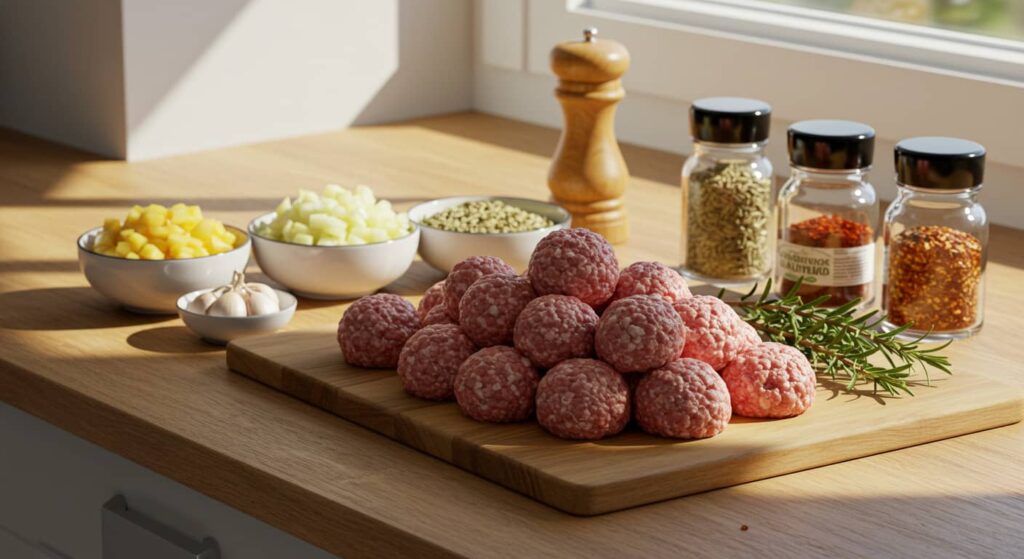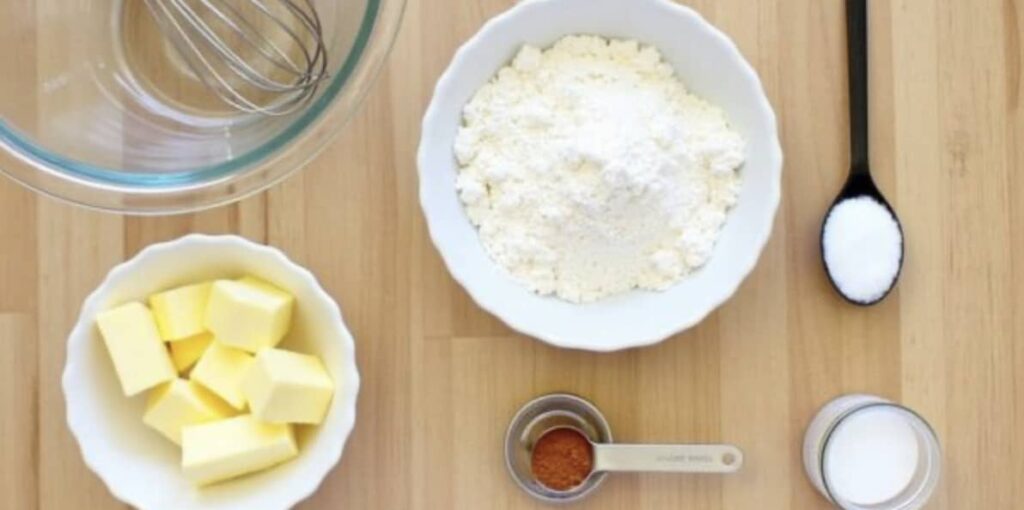What Can I Substitute for Bisquick in Sausage Balls? Have you ever been in the middle of whipping up some delicious sausage balls only to realize you’re out of Bisquick? 😱 Don’t worry; you’re not alone! Many home cooks have faced this culinary conundrum. Whether you’re looking for a healthier option, accommodating dietary restrictions, or just ran out of Bisquick, this article has got you covered with tasty alternatives and simple recipes. Let’s dive in!
Table of contents
Sausage Balls and Bisquick
Sausage balls are a classic appetizer or snack that combines ground sausage, shredded cheese, and a dry baking mix like Bisquick. They’re simple to make, incredibly tasty, and perfect for gatherings or meal prep. But what if you don’t have Bisquick on hand?
“Necessity is the mother of invention.” Sometimes running out of an ingredient is the perfect excuse to get creative in the kitchen!
Why Substitute Bisquick in Sausage Balls?
Common Reasons for Substitutions
- No Bisquick Available: It’s a pantry staple for some, but not everyone stocks it regularly.
- Healthier Options: You might be looking to cut down on processed ingredients or reduce calories.
- Dietary Restrictions: Gluten-free or low-carb diets might require a different approach.
Healthier Alternatives
Using alternatives can help you control ingredients, reduce sodium, or cater to specific dietary needs. Plus, some substitutes can add unique flavors to your sausage balls!
Key Ingredients in Sausage Balls

Sausage
Ground sausage is the heart of sausage balls. Choose your favorite variety, whether it’s spicy, mild, or even chicken sausage for a leaner option.
Cheese
Cheddar is the classic choice, but don’t shy away from experimenting with mozzarella, gouda, or pepper jack for extra zing.
Flour or Baking Mix
This is where Bisquick (or a substitute) comes into play. It binds everything together and gives sausage balls their structure and texture.
Best Substitutes for Bisquick
Self-Rising Flour
If you have self-rising flour, you’re halfway there! It already contains baking powder and salt, making it a fantastic one-to-one substitute for Bisquick in sausage balls.
All-Purpose Flour with Add-ins
Don’t have self-rising flour? Mix 1 cup of all-purpose flour with 1 1/2 teaspoons of baking powder and 1/4 teaspoon of salt. Voilà—a quick Bisquick substitute!
Homemade Baking Mix
Combine 2 cups of all-purpose flour, 1 tablespoon of baking powder, 1/2 teaspoon of salt, and 2 tablespoons of cold butter. Mix until crumbly, and you’re good to go.
Gluten-Free Options
For gluten-free diets, use a gluten-free all-purpose flour blend with a pinch of baking powder and salt. Almond or coconut flour blends also work well, though they may alter the texture slightly.
Creative Alternatives
Almond Flour Blend
Mix almond flour with a small amount of tapioca starch for a grain-free, low-carb option. This gives a nutty flavor to your sausage balls, making them extra unique.
Coconut Flour Mix
Coconut flour is highly absorbent, so use it sparingly—about 1/4 cup with an egg as a binder for every cup of Bisquick you’d normally use.
Pancake Mix
Believe it or not, pancake mix can work in a pinch. Just make sure it’s not too sweet if you’re using it for savory sausage balls.
Step-by-Step Guide to Making Substitutes
DIY Self-Rising Flour Recipe
To make self-rising flour:
- 1 cup all-purpose flour
- 1 1/2 teaspoons baking powder
- 1/4 teaspoon salt
Mix these ingredients thoroughly and store them in an airtight container. Use as needed for sausage balls or other recipes!
Homemade Gluten-Free Baking Mix

If you’re avoiding gluten, creating your own gluten-free baking mix is simpler than you might think. Here’s a recipe that works perfectly for sausage balls:
- 1 cup gluten-free all-purpose flour
- 1 tablespoon baking powder
- 1/4 teaspoon salt
- 1 tablespoon butter or coconut oil (chilled and crumbled in)
Blend these ingredients until crumbly, and store them in an airtight container for later use.
Common Issues When Substituting
Texture Variations
One common issue when substituting Bisquick is the texture. For example, coconut and almond flours are more absorbent and may make the mixture too dry. To fix this, add a splash of milk or an extra egg for better consistency.
Flavor Adjustments
Substitutes like pancake mix or almond flour may slightly alter the flavor profile. To counterbalance this, consider adding extra cheese or seasonings like garlic powder or paprika for a flavor boost.
Nutrition Facts of Sausage Balls
Here’s a quick breakdown of the approximate nutrition per serving of sausage balls made with Bisquick or substitutes:
| Nutrient | Per Serving (4 balls) |
|---|---|
| Calories | 180-220 |
| Protein | 10g |
| Carbohydrates | 15g |
| Fat | 12g |
| Fiber | 1-2g |
| Sodium | 400-500mg |
Adjusting the ingredients can tweak these values. For example, using almond or coconut flour lowers carbs while increasing fiber.
Tips for Perfect Sausage Balls Every Time
Want foolproof sausage balls? Here are some pro tips:
- Don’t Overmix: Overmixing can make the balls dense and tough. Mix just until the ingredients are combined.
- Use a Cookie Scoop: For uniform-sized balls, use a cookie scoop to portion the dough. This ensures even cooking.
- Pre-Cook the Sausage: If you’re worried about grease, partially cook the sausage before mixing it into the batter.
- Grease Your Baking Sheet: Even with parchment paper, greasing ensures the balls don’t stick and get that golden-brown crust.
Creative Recipes Using Bisquick Substitutes

Now that you’ve mastered the basics, why not take your sausage ball game to the next level? Here are a few fun and creative recipes you can try using Bisquick substitutes.
Cheddar Garlic Sausage Balls with Self-Rising Flour
Adding a hint of garlic elevates the flavor of these classic sausage balls. Here’s how to make them:
- Ingredients:
- 1 cup self-rising flour
- 1 lb ground sausage
- 2 cups shredded sharp cheddar cheese
- 1 teaspoon garlic powder
- 1/2 teaspoon black pepper
- Instructions:
- Preheat your oven to 375°F (190°C).
- In a large bowl, combine all the ingredients until well mixed.
- Roll the mixture into 1-inch balls and place them on a greased baking sheet.
- Bake for 20–25 minutes or until golden brown.
- Serve warm and enjoy!
Low-Carb Almond Flour Sausage Balls
For a keto-friendly version, almond flour is the star ingredient.
- Ingredients:
- 1 cup almond flour
- 1 lb ground sausage
- 2 cups shredded mozzarella cheese
- 1 egg
- 1/2 teaspoon paprika
- 1/2 teaspoon onion powder
- Instructions:
- Preheat your oven to 375°F (190°C).
- Mix all ingredients in a large bowl until thoroughly combined.
- Form the mixture into small balls and place them on a parchment-lined baking sheet.
- Bake for 20–25 minutes or until golden and firm.
- Cool slightly and serve. Perfect for a keto snack or appetizer!
Gluten-Free Sausage Balls with Pancake Mix
If you have gluten-free pancake mix, it works wonderfully as a substitute for Bisquick.
- Ingredients:
- 1 cup gluten-free pancake mix
- 1 lb ground sausage
- 2 cups shredded cheese (your choice)
- 1/4 cup milk
- Instructions:
- Preheat your oven to 375°F (190°C).
- Combine all the ingredients in a mixing bowl.
- Roll into balls and arrange on a greased baking sheet.
- Bake for 20 minutes or until cooked through.
- Enjoy warm or pack them for on-the-go snacks!
Serving Suggestions and Storage Tips
Sausage balls are incredibly versatile. Here’s how you can serve and store them:
Serving Suggestions
- Dipping Sauces: Pair your sausage balls with ranch, honey mustard, or a spicy sriracha mayo for added flavor.
- Party Platters: Arrange them alongside fresh veggies, crackers, and cheese for a crowd-pleasing platter.
- Breakfast Add-Ons: Serve sausage balls with scrambled eggs and toast for a hearty breakfast.
Storage Tips
- Refrigerator: Store cooked sausage balls in an airtight container in the fridge for up to 3–4 days.
- Freezer: Freeze uncooked sausage balls on a tray, then transfer them to a freezer bag. They’ll last up to 3 months.
- Reheating: Warm refrigerated or frozen sausage balls in the oven at 350°F (175°C) until heated through.
Frequently Asked Questions
Can I Skip Baking Mix Altogether?
You can, but you’ll need to replace it with an appropriate substitute like self-rising flour or one of the alternatives mentioned earlier. Otherwise, the sausage balls may lack structure.
What Cheese Works Best?
Cheddar is a classic for its meltability and sharp flavor, but feel free to experiment with Monterey Jack, Parmesan, or a blend of your favorites for a unique twist.
Can I Make Sausage Balls Ahead of Time?
Absolutely! Sausage balls are great for meal prep or party planning. You can prepare them a day or two in advance and store them in the refrigerator until you’re ready to bake. Alternatively, freeze them uncooked and bake straight from the freezer, adding a few extra minutes to the baking time.
Why Are My Sausage Balls Falling Apart?
If your sausage balls are crumbling, it’s likely due to a lack of moisture. To fix this, try adding an egg or a splash of milk to bind the ingredients better. Overly dry substitutes other than bisquick like coconut flour may require additional liquid to achieve the right texture.
What Type of Sausage Should I Use?
You can use any ground sausage for sausage balls. Pork sausage is a classic choice, but turkey or chicken sausage works if you’re looking for a leaner option. For a spicier kick, opt for hot sausage, or go mild if you prefer a more traditional flavor.
Can I Make Sausage Balls Without Cheese?
While cheese adds flavor and helps bind the mixture, you can make sausage balls without it. Consider adding a tablespoon of olive oil or an extra egg to compensate for the missing moisture and binding properties.
Can I Use Pre-Cooked Sausage?
Yes, but the texture will be slightly different. Pre-cooked sausage doesn’t bind as well as raw sausage, so you may need to add an egg or more cheese to hold the mixture together.
What’s the Best Way to Reheat Sausage Balls?
The best method for reheating is to use an oven or air fryer, as this helps maintain the crispy texture. Simply heat them at 350°F (175°C) for about 10 minutes. Microwaving is quicker but can make them slightly soggy.
Can I Add Vegetables to Sausage Balls?
Yes, adding finely chopped vegetables like bell peppers, onions, or jalapeños is a great way to enhance flavor and add nutrients. Just make sure the veggies are chopped small enough to blend well with the other ingredients.
Do I Need to Grease the Baking Sheet?
It’s highly recommended to grease your baking sheet or use parchment paper to prevent sticking. Even if your sausage contains fat, the cheese in the mixture can cause the balls to stick to the surface.
What Can I Use as a Vegan Substitute for Sausage?
If you’re going for a vegan version, use plant-based sausage crumbles and dairy-free cheese. You can also use flaxseed meal mixed with water as an egg replacement for binding the mixture.
Conclusion: A World Beyond Bisquick
So, what can you substitute for Bisquick in sausage balls? The answer is simple: almost anything! With a little creativity, you can make your sausage balls healthier, gluten-free, or just as indulgent as you like. Whether you’re using almond flour, self-rising flour, or pancake mix, the possibilities are endless. Now go ahead and impress your friends and family with your newfound sausage ball expertise. Happy cooking! 😄

